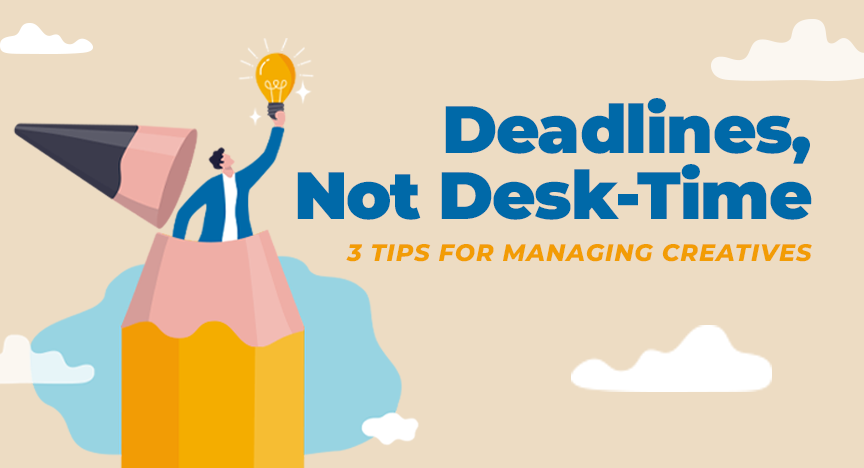3 Tips for Managing Creatives
Managing creative professionals can feel stressful for many managers in professional industries. It can feel like herding particularly vibrant, idea-generating cats.
Creatives are passionate, innovative, and often the lifeblood of groundbreaking projects. However, traditional management approaches, often rooted in an industrial-era focus on “desk-time,” can stifle their brilliance and lead to frustration for everyone involved. The truth is, when it comes to managing creatives, the emphasis needs to shift dramatically from when and where they work to what they deliver and when it’s due. In short: deadlines, not desk-time.
Here are three essential tips for effectively managing creatives, all centered around this crucial principle:
Tip 1: Define Clear Outcomes, Not Rigid Processes
Micromanaging will kill a creative’s process. One of the biggest mistakes managers make with creatives is trying to micromanage their process. How many times have you heard, “Why aren’t you at your desk?” or “You need to be in the office from 9 to 5”? These questions fundamentally misunderstand the creative process. Inspiration doesn’t punch a clock. A brilliant concept might strike during a morning run, while staring at a ceiling, or in the dead of night. Forcing a creative into a rigid structure often leads to less, not more, innovation.
Instead, focus on defining crystal-clear outcomes. What is the deliverable? What are the key objectives it needs to meet? What problem should it solve? Provide a comprehensive brief that outlines the project’s scope, target audience, brand guidelines (if applicable), and most importantly, the desired end result. Then, give your creatives the autonomy to determine the how. Trust them to find the most efficient and effective path to achieve that outcome.
For example, instead of saying, “I need you to work on this ad campaign mock-up for eight hours today,” try, “I need a first-round mock-up for the new ad campaign by Friday, ensuring it aligns with our Q3 marketing goals and resonates with our Gen Z demographic.” The latter empowers the creative to work when and how they’re most productive, knowing exactly what success looks like. This freedom, coupled with clear expectations, fosters a sense of ownership and often leads to more inspired and original work.
Tip 2: Implement Phased Deadlines and Regular Check-ins, Not Constant Surveillance
While giving creatives autonomy over their process is vital, it doesn’t mean a free-for-all. Deadlines are not suggestions; they are the framework that ensures projects progress and are delivered on time. The key is to break down larger projects into manageable phases, each with its own clear deadline. This approach provides structure without stifling creativity.
Instead of one looming final deadline weeks or months away, implement smaller, incremental deadlines for specific milestones. For a video project, this might include deadlines for script approval, storyboard completion, initial edit, and final cut. For a design project, it could be concept approval, first-round designs, revisions, and final artwork.
These phased deadlines serve several crucial purposes:
- Preventing Procrastination: Smaller deadlines keep creatives engaged and prevent them from leaving everything to the last minute.
- Early Problem Identification: If a creative is struggling with a particular phase, you’ll know much sooner, allowing for intervention and support before it derails the entire project.
- Maintaining Momentum: Regular, achievable goals provide a sense of accomplishment and keep the project moving forward.
Complement these phased deadlines with regular, but not intrusive, check-ins. These aren’t about monitoring their “desk-time” or micromanaging their every move. Instead, they’re opportunities to discuss progress against the established deadlines, address any roadblocks, offer feedback, and provide support. Think of them as collaborative touch points, not performance reviews. A quick 15-minute sync-up to ensure they’re on track for a specific deliverable is far more effective than an hour-long meeting dissecting their daily activities.
Tip 3: Trust and Transparency: The Bedrock of Deadline-Driven Management
Ultimately, managing creatives effectively boils down to trust. If you hired them for their creative talent and expertise, you must trust them to deliver. This trust is not blind; it’s earned through clear communication, well-defined expectations, and consistent follow-through on both sides.
Be transparent about project goals, budget constraints, and any potential challenges. Creatives are more invested when they understand the bigger picture and feel like valued partners, not just cogs in a machine. This transparency also extends to how you communicate about deadlines. If a deadline needs to shift, explain why. If there are external factors impacting the project, share that information.
Conversely, creatives must also be transparent if they anticipate missing a deadline. Encourage them to communicate proactively rather than waiting until the last minute. Foster an environment where it’s safe to raise concerns or ask for help without fear of reprisal. This open dialogue is crucial for successful project management and for maintaining a healthy working relationship.
When you shift your focus from monitoring “desk-time” to empowering creatives to meet “deadlines,” you unlock their full potential. You move from a system of surveillance to one of partnership, fostering an environment where innovation thrives, projects are delivered on time, and everyone feels respected and valued. Embrace the power of the deadline, and watch your creative teams flourish.

